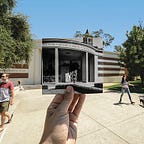Twigs are light, right?
A firsthand account of the installation of Charles Arnoldi | Four Decades
Today’s blog post is written by Fisher Museum Collections Manager and Registrar Stephanie Kowalick.
Every exhibition installation is unique and this one was no exception. Having been to Chuck’s studio and seen his works in person, I thought I was adequately prepared for the process of installing his exhibition but can you really prepare when an artist works as creatively as Charles Arnoldi?
From simple branch forms that were light as a feather to solid plywood pieces shaped with a chainsaw to colorful canvases arranged together, nothing was “business as usual” in this exhibition. Most of the time you hang a painting and it is a straightforward process of putting hardware on the wall and hanging off it. Not so with Chuck’s work.
The work I thought would be one of the most difficult — Broken Memory (at left), which features at least two fragments of a chair, was relatively simple and satisfying as we watched the work’s two sides “click” together.
Whereas other more straightforward and traditional looking works like Norman were surprisingly heavy due to their substantial metal framing. A number of Chuck’s two-dimensional works are actually smaller canvas squares framed together. When you think of the materiality — canvas, wood, and metal, it adds up pretty quick.
Another delightful surprise was seeing all the notes Chuck has left on the back of his own work. Previous titles revealed themselves as we uncrated the items and instructions such as the ones on Quake (below) made our entire team laugh.
One of my favorites was seeing the year of my birth written on the back of Final Ordinance one of Chuck’s chainsaw works in the show. The smell of the wood evoked for me the memory riding an old wooden roller coaster in the summer time. Not to mention my delight in knowing something in the show was as old as me (of course several other works pre-dated me as well).
Each artwork presented a challenge to our entire team, which kept all of us on our toes and made for a fun if sometimes physically exhausting installation. Once you get the hang of one or two heavy things (like 600 lbs heavy!), you do get into a rhythm. We only had a week to install this show. Strategizing ahead of time worked to our advantage as did the number of people we had available to help including our secret weapon, Chuck’s studio assistant Jacob Melchi. Jacob knows Chuck’s pieces intimately and his advice became the gold standard for us as we worked.
I would like to think we handled this exhibition as resourcefully as Chuck paints but I think his years of expertise far outweigh ours. What I can say is that the show came together beautifully and our 1939 architecture proved to be a delightful background for Chuck’s strong, bold, and innovative works.
Charles Arnoldi | Four Decades from the Collections of Jordan D. Schnitzer and His Family Foundation is on view through Saturday, April 4, 2020.
